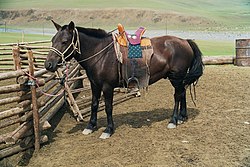Mongolian horse
| Mongolian horse | |
|---|---|

|
|
| Important data | |
| Origin: | Mongolia |
| Main breeding area: | Mongolia |
| Distribution: | Mongolia , Inner Mongolia |
| Stick measure : | 130-145 cm |
| Colors : | all |
| Main application area: | Riding horse, pack horse, dairy farming, slaughter |
The Mongolian horse ( Mongolian Морь , Morj ; [mœɾ] ) is an important and popular livestock in Mongolia , which played an important role in the conquest of Genghis Khan . The traditionally living nomads keep over 3 million animals, consequently there are significantly more horses in the country than human inhabitants. The Mongolian horse is a small horse .
The horses in Mongolia live outdoors all year round (at 30 ° C in summer to −40 ° C in winter) and look for their own food. They provide milk for the national drink Airag and sometimes also meat. Furthermore, they serve as mounts, both for the everyday work of the nomads and for horse races . The horse industry is of increasing importance for meat production, with Mongolia in particular aiming to increase meat exports to Japan, Korea and, in the long term, to China. Last but not least, they are an important factor in the tourism industry.
Background information on horse evaluation and breeding can be found under: Exterior , interior and horse breeding .
Exterior
These horses are stocky in appearance, with low build and large heads. To some, they may be vaguely reminiscent of a wild horse .
The mane and tail are very long, the hair is therefore used as a material for tying ropes and the tail hair in particular can be found on violin bows all over the world . The hooves are very robust, which is why very few animals are shod.
interior
Mongolian horses are very frugal, persistent and sure-footed in the field.
Most horses are kept free-roaming in Mongolia, only the mounts are caught and tied up. Once the animal has got used to the rider, it is usually a reliable mount.
The Mongolian riding saddle is built very high out of wood and allows only little control of the gait. That is why the decision about which gait to take usually falls to the animal, and the rider can take care of his other tasks (e.g. driving cattle). Quite often a Mongolian horse will fall into the tölt on its own , so it is a gaited horse .
With a child in the saddle, racehorses cover up to 35 km at a stretch in a straight gallop. They are trained to keep running to the finish even if the rider falls, and then have to be slowed down and stopped by specially provided helpers.
Breeding history
The exact origins of the breed are difficult to determine. Riding horses have been with the nomads of the Central Asian steppes since 2000 BC. Documented. Studies show that the Mongolian horses have the greatest genetic diversity of all horse breeds, followed by the Tuvinian horses. This indicates that it is a very original breed with comparatively little influence from breeding. The data also shows that some other horse breeds of today are descended from the Mongolian ones.
See also
Individual evidence
- ↑ Udina IG: Computer Analysis of D-Loop of Mitochondrial DNA Variation in Asian Horse Breeds ( PDF ). In: The Third International Conference on Bioinformatics of Genome Regulation and Structure (BGRS 2002)
- ↑ Tozaki et al .: microsatellite variation in Japanese and Asian Horses and Their Phylogenetic Relationship Using a European Horse outgroup . In: Journal of Heredity 2003: 94 (5);